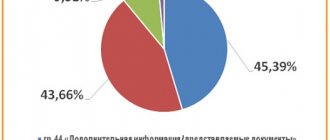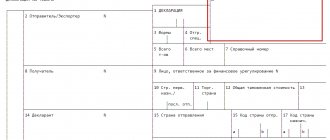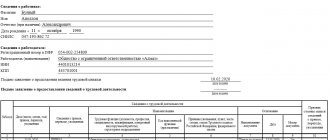If goods intended for one’s own needs are transported across the border of the Russian Federation, it must be properly registered. In this case, a passenger customs declaration is issued. With such a document, individuals have the right to transport goods intended for home, family and personal use. The main condition is that the transported goods should not be transported for business purposes.
Files for download:
Form
Sample
Document requirements
The form is contained in the Decision of the Customs Union Commission No. 422 of October 14, 2010. The basic filling requirements are also listed there. In accordance with current legislation, the declaration for a car to cross the Russian border consists of one sheet of A4 format. It must be filled out in two copies. One is taken away at customs, the second one is kept by the declarant.
When filling out, adhere to the following rules:
- Fill out in a printed form (use the Excel form and print it out) or by hand, but legibly.
- Do not correct, do not leave blots.
- Provide all information about the car in the original language, use the Latin or Cyrillic alphabet.
- If there is not enough space in the columns, use the reverse side of the form. If this is not enough, attach additional sheets.
- Certify with your signature and personal seal and signature of the official all data provided outside the main fields of the form.
- Make changes by carefully crossing them out and writing the correct information at the top.
- Certify all changes with the signature and seal of an authorized person.
Although the document exists in two copies, each party fills out not a separate copy, but its own part of the form.
For foreign trade participants
The carrier representative works with the top of the form. The customs declaration for a car itself consists of fields for entering text and boxes for ticking. The first points include:
- Vehicle. It is necessary to register the make, model, type according to the vehicle classifier (in accordance with the Decision of the Board of the Eurasian Economic Commission dated May 12, 2015 No. 52), number and country of registration according to the classifier of countries of the world, VIN number.
- The person carrying out the transportation. This refers to the name of the carrier and full name. his representative.
- Route. For all types of vehicles, the country and destination are indicated here, and for aircraft, the flight number is also added.
- Purpose of import, export. They indicate whether this is the beginning or completion of international transportation, whether it is carried out on the territory of the EAEU or outside it.
- Signature of the person and date of completion.
All other cells are marked with ticks or crosses. The exception is paragraph 7. If there are passengers, a number corresponding to their number is placed instead of the sign. If in paragraph 10 we select “Yes”, then write down the names of spare parts and their quantity next to it.
For a customs broker
He assumes the functions of the declarant. Therefore, he also needs to work with the top part of the declaration. Only point 13 differs. There the broker will add the details of the document on its inclusion in the register of representatives and enter the number of the contract for the provision of services to the carrier.
For customs
Officials put marks at the bottom of the form. Each of the three columns is filled at different times - in accordance with the stages of transportation.
When is it issued?
According to paragraph 3 of Article 105 and paragraph 3 of Article 260 of the Customs Code of the EAEU, a passenger customs declaration (the usual abbreviation - PTD) is used when it is required:
- declare goods when crossing the border (we are talking about goods for personal use, not for commercial purposes);
- place goods under a special customs procedure of customs transit.
Also, the PDD is provided at its discretion in relation to goods for personal use that are not subject to customs declaration (clause 10 of Article 260 of the EAEU Labor Code).
You do not need to fill out a PTD if you are transporting items across the border whose weight and value fall within the duty-free import limit. In 2021, this limit is as follows.
| Air Transport | Up to 10,000 euros | Up to 50 kg |
| Land, sea and river transport | Up to 500 euros | Up to 25 kg |
| International postal items | Up to 200 euros | Up to 31 kg |
Frequent mistakes when filling out a customs declaration
The most common mistake is filling out the “wrong” part of the form. This does not happen with customs officers, but declarants often mistakenly enter incorrect information in the lower part.
There are also such errors:
- Misprints, typos and subsequent discrepancies between the information on registration documents and the information in the declaration.
- Presence of blots, erasures, illegible handwriting.
- Lack of certification of corrections or additional sheets.
- Indication of an incorrect date, that is, different from the day of arrival of the vehicle.
- Entering unnecessary information, for example, about the goods being transported. They are declared in a separate document.
If errors are detected, customs has the right to force the declarant to fill out a new form.
Is it possible to fill it out on the customs website?
Electronic submission of documents is the priority method of declaration. A special service has been created on the customs website that allows you to send a declaration through a closed communication channel. Filling out a customs declaration on the customs website requires registration and obtaining an electronic signature. To do this, go to your Personal Account. The site contains all the necessary sources: legal framework, classifiers that are necessary to fill out the document, and reference books.
Penalty for failure to declare
According to Article 16.2 of the Code of Administrative Offenses of the Russian Federation, an administrative fine is imposed on a citizen or organization for failure to declare a vehicle. It ranges from 0.5 to two times the cost of the vehicle. Confiscation of the latter is also possible.
If the declaration was carried out late and the regulatory authority did not have time to notify the carrier of prosecution, a fine can be avoided.
If the document itself exists, but it contains false information, the declarant is also responsible. But only if these data led to an underestimation of the amount of duties or exemption from their payment. The violator will pay a fine in the amount of 0.5 to two times the amount of lost duties. There is also a risk of confiscation.
Procedure for filling out cargo TD
The declaration form for goods - CCD is approved by the Customs Union Commission and consists of several forms-sheets in A4 format or a small brochure. The declaration is filled out according to the rules established in the order of the State Customs Committee “On approval of the Instructions on the procedure for filling out the customs declaration.”
1. Main sheet of TD 1.
Filled out for goods that have one name for a single declared mode of movement. The main sheet includes four copies: the first - for the customs archive, the second - for the customs statistics department, the third is a financial reporting document and is returned to the declarant, the fourth sheet is attached to the accompanying documents for the cargo and is sent to the customs point where the procedure will take place customs clearance.
The basic information contained in sheet TD 1 must be filled out by the declarant. The customs authority fills in column No. 7, where a mark is placed on the acceptance of the document for customs clearance, as well as columns 43, C, D, which consistently indicate the phased passage of customs clearance and control.
2. Sheet of the TD form 2.
The document must be completed if the cargo contains goods of several types. No more than three names can be declared on one additional sheet. The structure and rules for filling out sheets of TD 2 are completely similar to form TD 1. The number of sheets of form TD 2, which can be additionally filled out by the declarant, is not limited by law.
Our company deals with customs clearance and delivery of cargo from abroad. Read more about the service here.
Preparation of transport documentation
Get a free consultation
Call us or fill out the feedback form and we will contact you as soon as possible.
8 800 700 0952 Feedback
Features of declaration in the Customs Union
The economic zone of the Customs Union includes 5 countries: Russia, the Republic of Belarus, the Republic of Kyrgyzstan, the Republic of Kazakhstan, Armenia, which form a single customs territory. In other words, when exporting and importing most types of cargo across the borders of these countries, customs payments are not made and there is no need to draw up a customs declaration.
The rules for declaring goods on the territory of the Customs Union are described in Chapter. І Instructions No. 257. For example, in Kyrgyzstan and the Russian Federation, a declaration for vital drugs is issued as for one type of cargo if they have identical composition, name and release form.
When indicating in the declaration several names of goods with different HS codes, you can not draw up additional sheets, but only attach a list of goods to the main one, indicating the codes and cost of products.
Important! If the document is submitted on paper, the declarant is required to provide a copy of the TD in electronic form. It is allowed to attach numbered additional sheets to the declaration for the comments of customs specialists. These additions are part of the declaration, so they must also be present in the electronic version.
How to fill out the Customs Declaration?
Tourists often have various kinds of difficulties with filling. Let's look at a guide on how to fill out a US customs declaration to avoid possible misunderstandings in the future.
To get started, we suggest watching a sample filling in the following video:
Now let’s look at the step-by-step filling out of the declaration in Russian:
- Last name, first name and middle name (you need to skip this line, since we don’t have a middle name).
- Date of Birth. At this point, you should pay special attention to the order in which you need to enter the information: first fill in the month, and then the day and year of birth.
- How many other family members are traveling with you (not including yourself).
- The address where you plan to temporarily stay in the country (hotel name/destination). In the first line of this paragraph you only need to enter the house number and street (in that order), and in the second line indicate the city and state.
- Which country issued your passport?
- International passport number.
- The country in which you reside permanently.
- Which countries did you visit on this trip before arriving in the USA? If your flight was direct, then simply leave this line blank. If your route was built with a transfer somewhere, for example, in England, then you need to enter it.
- Name of the airline you used/flight number or ship name.
- Is the main purpose of your trip business? Here you just need to tick the “yes” or “no” box, respectively.
Next, from 11 to 14, there are paragraphs that relate only to items prohibited for import or subject to declaration. You should familiarize yourself with their list in advance, even before your trip. If you do not have such things with you, then all items should be checked in the “no” column. If you are bringing products that require permission, then tick the “yes” box in the appropriate boxes, and also provide customs officers with documented permission to import them into the country.As for the import of currency into the United States over $10,000, it must be declared. At the same time, additional data should be indicated in the customs passenger declaration, such as the name of the issuer, date of issue, TIN if available, information about the source of origin of funds, their method of transportation, etc.
- I'm taking with me:
- fruits, vegetables, plants, seeds, food, insects;
products of animal origin;
- pathogenic bacteria, cell cultures, snails;
- soil, or I was on a farm/ranch/pasture.
For visitors to the country, the sum of all goods that will remain in the United States, including commercial goods, amounted to an “enter amount.”
Fill in the “Description of Articles” field. The cost of goods that you wish to leave in America (for example, gifts), if any, is indicated as approximate. All of them must be specified in the declaration, and on the reverse side, each of these goods is assessed by filling out (there is a special column for this). It looks like this:
- Box of Ukrainian chocolates, cost – $50;
- A bottle of ABSOLUT vodka, cost – $70;
- Ukrainian coffee, cost – $30.
The total amount is $150.
If there are no such products, then the corresponding column should simply be left empty.
If the total value of the “gifts” brought into the United States is large enough, then you will have to pay customs duty for them. Its size is determined by the customs officer. Most often, US residents can bring goods into the country without paying duty in an amount not exceeding $800, and tourists - not exceeding $100.
Then the date of completion is indicated on the form and a signature is placed. By placing your signature on the completed declaration, you thereby take responsibility for the accuracy of all the data contained in it.
Next, you should double-check the completed document to ensure that all entered data is correct and complete. Only after this can the customs declaration be considered completed.
What documents are submitted along with the customs declaration?
Along with the goods declaration, the following documentation is submitted to the customs authority where registration takes place:
- a document certifying the authority of the declarant to submit a customs declaration on his own behalf;
- transport documents confirming the movement of cargo across the border of the Russian Federation;
- foreign economic transaction passport (copy);
- declaration of customs value;
- documents confirming control of delivery of goods;
- receipts for payment of customs duties;
- a copy of the customs declaration on electronic media.
Until the completion of registration, the declaration is not handed over to the submitter and remains only with the customs authority. After fulfilling all conditions and submitting the necessary documentation, the customs declaration is registered and receives legal force.
Rules for revocation of TD
If it is necessary to make changes or choose an alternative customs procedure for clearing the cargo, as well as in cases provided for by the Customs Code of the Customs Union, the declarant can revoke the TD submitted to customs. This is done by means of a written or electronic application for revocation to Customs. Key points to know about this procedure.
- Revocation of a customs declaration is carried out only with permission from customs.
- The declarant cannot be refused to register an appeal regarding the revocation.
- TD for goods of the Customs Union, as well as TD for goods of foreign origin specified in Art. 302 of the Customs Code, can be withdrawn up to the moment when the cargo actually leaves the territory of the Customs Union, that is, has already been released by customs.
- If the customs office makes a positive decision on the revocation, the declarant must submit a new TD within the time frame for temporary storage of goods (4 months from the date of their placement in storage).
- If the deadline for filing a new TD is not met, the goods will be detained at customs in accordance with the provisions of the EAEU Customs Code.
The withdrawal permit, as well as the refusal, are issued by customs in written or electronic form.
In what cases is GDT mandatory?
1) The first method is simple compared to the second, because the owner of the vehicle will need to submit an application to the appropriate authorities, after which it will become half official.
This document must be written in any form and contain complete information about the goods with which the carrier intends to cross the state border. This declaration option is valid only if the total total value of the entire product is no more than 7,000 thousand rubles, or 100 EUR.
The main fields in the application are required to be filled out:
- Full name and legal address of the carrier who transports the declared cargo across the border.
- A complete list of goods transported abroad, indicating their full quantity and the barcode of each product.
2) The second method will be described in more detail below, since it is in the second method that it is necessary to fill out the customs declaration.
In order for the transported goods to be declared using the customs declaration, the carrier needs to write a special written application that contains complete information about the carrier itself, as well as complete comprehensive information about the transported goods.
The application is drawn up on special customs forms and written on two sheets of paper - this is not without reason. And all because the first sheet is the main one for the gas customs declaration, and the second is additional.
The first form TD1 consists of four self-copying sheets:
- The first copy is given to customs,
- The second instance is statistical,
- The third copy remains in the hands of the carrier for crossing the border on the way back,
- And the final, fourth copy is itself a regional specimen.
If you are transporting goods of different subgroups, you need to fill out both declarations at the same time: TD1 and TD2. The second declaration is an integral part of the customs declaration.
Registration of the declaration in electronic form
Electronic declarations are submitted from a personal account on the customs authority resource. A prerequisite is the presence of an electronic signature of the foreign trade participant. Declaration in this version takes place in three stages: creation of an electronic document (main and, if necessary, additional sheets); filing a declaration at the FCS site; verification of TD by customs officers and related documentation. At the last stage, inspection of the goods is possible.
Then the customs service makes a decision - to release the goods or refuse to release them. Having received a positive decision, the declarant has the right to make changes to the TD.
When is simplified customs declaration possible?
The simplified declaration scheme is regulated by CU letter No. 04-58/0117 dated January 16, 2012. Such registration is possible for authorized economic operators (consignees, owners of temporary storage warehouses, participants in foreign trade activities operating under a duty-free trade scheme, carrier companies, customs brokers). Simplified declaration provides some advantages during customs clearance:
- short processing time (1 day instead of 3);
- making corrections to the technical documentation before and after the release of goods;
- duties can be paid until the end of the cargo storage period;
- as a result, the cargo crosses the border much faster than the standard deadlines provided for this.
Thus, in order to obtain the right to undergo a simplified procedure, you need to write an application for inclusion in the register of authorized economic operators. Conditions for a positive decision: experience as a participant in foreign trade activities for at least a year, the absence of bankruptcy proceedings against the legal entity and the absence of problems with the law from the head of the company.
Where to get a TD registration number
Since the customs declaration contains a column for indicating the registration number, inexperienced declarants are often confused about where to get this number. In the registration procedure, everything happens sequentially:
- The declarant submits the TD to the customs authority.
- The inspector checks the accuracy of the declared data with the actual properties of the cargo and the correctness of filling out the form (errors and inaccuracies are unacceptable).
- If there are no complaints about the contents of the cargo and the execution of the declaration, the customs inspector assigns a registration number to this document, endorsing it with an individual stamp.
- The declarant provides documents to the customs office regarding payment of fees and duties in advance.
- The inspector endorses the document with the “Release Permitted” stamp.
From this moment on, the goods are considered released by customs and approved for use throughout the entire Customs Union.







